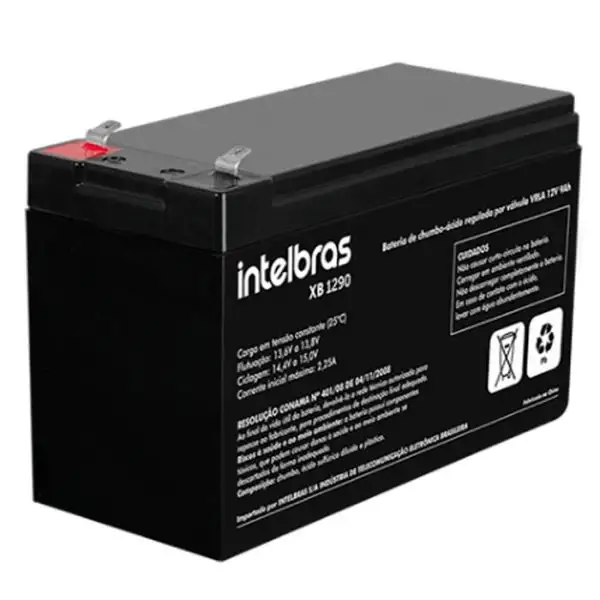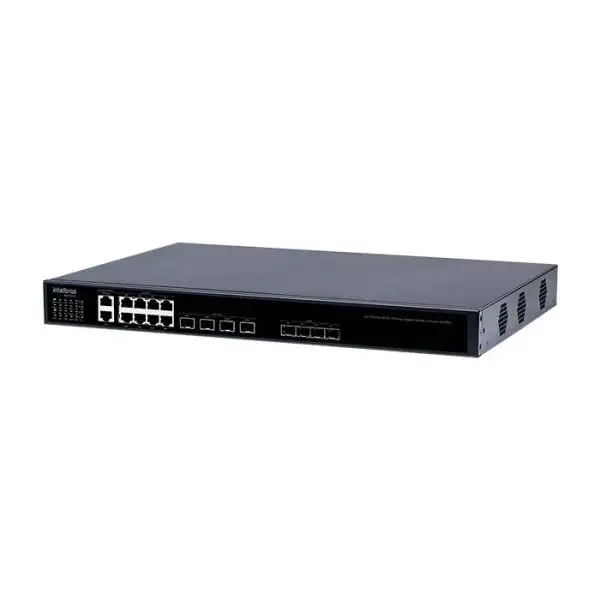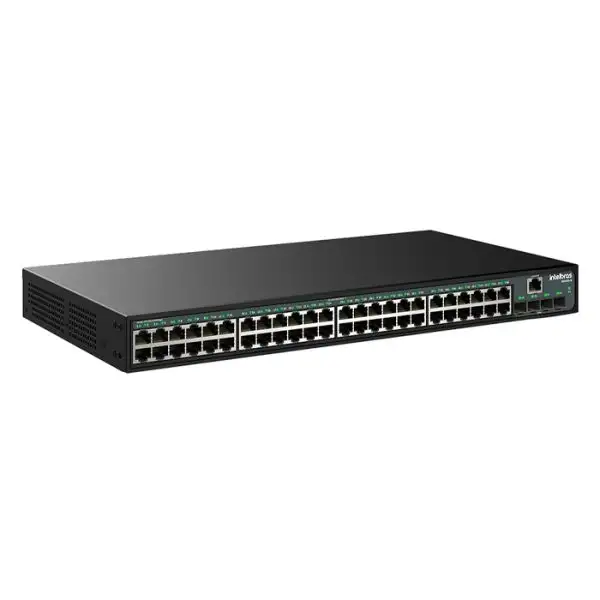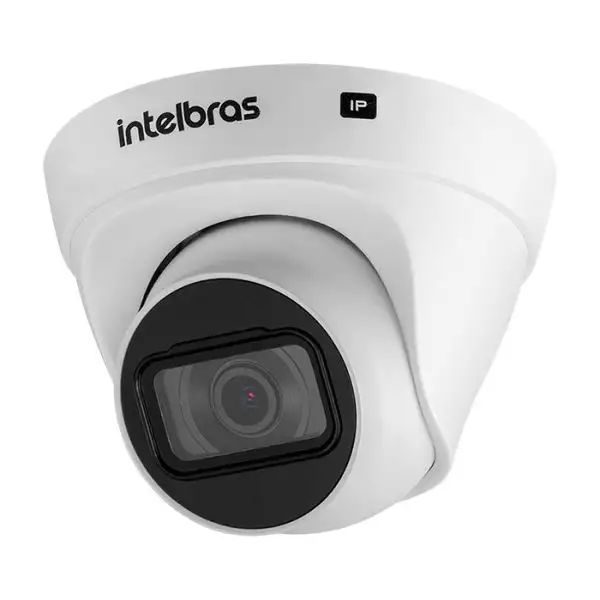Descrição
Portas SFP+
As 4 portas SFP+ garantem alto desempenho à rede, possibilitando conexões uplinks de até 10 Gbps.
Maior controle de rede
Os protocolos SNMP e RMON permitem monitorar os recursos do switch, facilitando o gerenciamento da rede.
Roteamento estático
O roteamento direto no switch acelera o tráfego de dados entre redes distintas, evitando tráfego desnecessário entre equipamentos.
Compatível com IPv6
O Switch S2328G-B é a solução ideal para redes IPv6, oferecendo maior capacidade, segurança e privacidade para a sua rede.
Autenticação IEEE 802.1X
Proporciona segurança aprimorada, autenticando os dispositivos conectados à rede e impedindo acessos não autorizados.
O S2352G-B vem equipado com 48 portas Gigabit Ethernet, proporcionando maior capacidade de tráfego de dados, e 4 portas SFP+, permitindo a operação em redes híbridas. Além disso, ele possui a função VLAN, que possibilita a segmentação da rede, oferecendo maior segurança e privacidade aos usuários conectados.
Principais Características:
– 48 portas Gigabit Ethernet (10/100/1000 Mbps) para maior capacidade de tráfego de dados.
– Com 4 portas SFP+, o switch oferece alto desempenho à rede por meio de conexões uplink de até 10 Gbps.
– A função VLAN possibilita a segmentação da rede, garantindo mais segurança e privacidade para os usuários.
– Monitoramento remoto e centralizado dos dispositivos conectados via protocolo SNMP para um maior controle da rede.
Especificações Técnicas:
– Chipset: Marvell: Marvel Alleycat3 – 1 Core, 800MHz
– Memória: 512 MB
– Memória Flash: 256 MB, dual boot image
– Dimensões (L × A × P): 440 mm x 44 mm x 178 mm / Acompanha suporte para rack padrão EIA / Altura: 1 U (acompanha suporte)
– Material: Aço
LEDs:
– SYS: Verde, amarelo e vermelho
– Port Status: Verde
Portas:
– Portas RJ45 Gigabit Ethernet (10/10/1000 Mbps): 48
– Portas SFP+ (1GB /10 GB): 4
– Portas console: 1
Cabeamento Suportado:
– 10BASE-T: Cabo UTP categoria 3, 4, 5 (máximo 100 m), EIA/TIA-568 100Ω STP (máximo 100 m)
– 100BASE-TX: Cabo UTP categoria 5, 5e (máximo 100 m), EIA/TIA-568 100Ω STP (máximo 100 m)
– 1000BASE-T: Cabo UTP categoria 5e, 6 (máximo 100 m), EIA/TIA-568 100Ω STP (máximo 100 m)
– 1000BASE-SX: Com uso de transceiver
– 1000BASE-LX: Com uso de transceiver
– 10GBASE-SR: Com uso de transceiver
– 10GBASE-LR: Com uso de transceiver
– 10GBASE-T: Com uso de transceiver
Alimentação:
– Alimentação Entrada: 100-240 Vac / 50-60 Hz (Bivolt Automático)
– Potência de consumo (sem link): 26 W (220v)
– Potência máxima de consumo: 50 W (220v)
– Disposição da fonte: Interna
– Proteção contra surtos: 8 kV (Em modo comum)
Ambiente:
– Temperatura de operação: 0 ºC a 40 ºc
– Temperatura de armazenamento: -40 ºC a 70 ºC
– Umidade de operação: 10% a 90% sem condensação
– Umidade de armazenamento: 5% a 90% sem condensação
– Emissão de segurança e outros: Anatel 15525-23-00160
Especificações de Hardware:
– Método de comutação: Armazena e envia (Store-and-Forward)
– Backplane (Capacidade de comutação): 176 Gbps
– Tabela de endereço MAC: 16 K
– Jumbo Frame: 10000 Kbytes
– Buffer de memória: 1.5 M
– Mean Time Between Failures: > 1.008.090 horas (~115 anos)
– Taxa de encaminhamento de pacotes: 130 Mpps
– Fan: 1
– Latência:
– 100 Mbps Latency < 9.55 μs (64-byte packets)
– 1 Gbps Latency < 2.700 μs (64-byte packets)
– 10 Gbps Latency < 1,4 μs (64-byte packets)
– VLAN: 4094
– Interface VLAN: 32
– Tabela de roteamento IPv4: 512
– Tabela ARP IPv4: 128
– Entradas ACL IPv4: 512
– Entradas Multicast L2: 1000
– Fila QoS: 8
– Grupos de agregação: 24 (Máximo 8 portas por grupo)
– Tabela de roteamento IPv6: 256
– Entradas ACL IPv6: 256
Configuração de portas:
– Configuração manual e automática do modo de operação, half-duplex e full-duplex
– MDI/MDI-X
– Espelhamento de portas (4 Grupos)
– Espelhamento de tráfego
– RSPAN
– Supressão de tempestade com base na porcentagem de largura de banda da porta
– Supressão de tempestade com base em PPS (Pacotes por Segundo)
– Supressão de tempestade com base em BPS (Bits por Segundo)
– Supressão de tráfego de broadcast/tráfego multicast/supressão de tráfego de unicast desconhecido
– Controle de fluxo 802.3x
– CSMA/CD
– Interface range
Agregação de link:
– GE/10GE port aggregation
– Agregação de link dinâmico (LACP)
– Agregação de link manual
– Algoritmo de balanceamento baseado em: Endereço IP de origem e destino, Endereço MAC de origem e destino, VLAN, Protocolo
Tabela MAC:
– Permite configurar o número máximo de endereços MAC de
– porta a serem aprendidos.
– Blackhole MAC address
– Endereço MAC estático
– Endereço MAC dinâmico
VLAN:
– VLAN baseada em porta
– VLAN baseada em MAC
– VLAN baseada em Protocolo
– VLAN Baseada em IP Subnet
– Espelhamento de VLAN em interface
– Guest VLAN
– Voice VLAN
– 4K VLANs ativas e 4K VLANs Ids
– VLAN baseado em Tag 802.1Q
– VLAN Hibrida
– VLAN UNTAG
– Dynamic VLAN
– VLAN Mapping
– PVLAN
– MVRP
Spanning tree:
– STP/RSTP/MSTP/PVST/PVST+ (até 32 instâncias)
– STP Root Protection
– Edged-port
– BPDU Drop
– G.8032 ERPS (Ethernet Ring Protection Switching) com tempo de failover inferior a 50 ms
Gerenciamento Multicast:
– IGMP Snooping v1/v2/v3 (256 grupos)
– PIM Snooping
– MLD Snooping
– Multicast VLAN
QoS:
– Limite de taxa de porta (recepção e transmissão)
– Redirecionamento de pacotes
– Taxa de acesso comprometido (CAR)
– Oito filas de saída em cada porta
– Algoritmos flexíveis de agendamento de filas com base em portas e filas, incluindo SP, WRR e SP+WRR
– Remarcação do DSCP 802.1p – DIFFSERV
– Implementação do QoS IEEE 802.1p em tempo real
Segurança:
– Gerenciamento hierárquico de usuários e proteção por senha
– Suporte à autenticação AAA
– Web authentication
– Autenticação RADIUS
– HWTACACS
– SSHv2 – 16 sessões
– Isolamento de porta
– Autenticação 802.1X, autenticação MAC centralizada
– Port Security
– IP Source Guard
– ARP Detection
– Dynamic ARP Inspection
– ARP speed limit
– HTTPs
– DoS attack detection
– ARP anti-attack
– TCP attack defense
ACL:
– Filtragem de pacotes na camada 2 até a camada 4
– Classificação de tráfego com base em endereços MAC de origem/destino, endereços IPv4/IPv6 de origem/destino e Porta TCP/UDP de origem/destino
– ACL baseada em time-range
– ACL baseada em VLAN
DHCP:
– DHCP Client IPv4 e IPv6
– DHCP Snooping IPv4 e IPv6
– DHCP Snooping option82
– DHCP Relay
– DHCP Server IPv4 e IPv6
– DHCP auto-config
Gerenciamento:
– Carregamento e atualização de firmware através de XModem/FTP/TFTP/Web/SCP
– Provisionamento Automático (Zero Touch Provisioning)
– Configuração por meio de CLI, Telnet,porta de console, SSH, HTTP e HTTPS
– SSH: Client & Server
– SNMPv1/v2c/v3 e NMS baseado na Web
– sFlow V5
– Restful
– Monitoramento remoto (RMON) de alarme, eventos e gravação de histórico
– 4 grupos RMON
– INC NMS
– Log do sistema, alarmante com base em severidades e saída de informações de depuração
– NTP
– Ping, Tracert
– NQA
– Teste de cabo virtual (VCT)
– Protocolo de detecção de link de dispositivo (DLDP)
– LLDP, LLDP-MED
– ND Snooping
– Monitoramento e alarmes de CPU,Memória, Temperatura, Fan e Fonte
– EEE
– Detecção de loopback
L3:
– BFD
– Static routing
– ARP Proxy
– VRRP
– Interface VLAN IPv4 e IPv6
Padrões e Protocolos:
– 802.1x Port based network access control protocol
– 802.1ab Link Layer Discovery Protocol
– 802.1ak MVRP and MRP
– 802.1ax Link Aggregation
– 802.1d Media Access Control Bridges
– 802.1p Priority
– 802.1q VLANs
– 802.1s Multiple Spanning Trees
– 802.1ag Connectivity Fault Management
– 802.1v VLAN classification by Protocol and Port
– 802.1w Rapid Reconfiguration of Spanning Tree
– 802.3ad Link Aggregation Control Protocol
– 802.3az Energy Efficient Ethernet
– 802.3ah Ethernet in the First Mile
– 802.3x Full Duplex and flow control
– 802.3 – 10BASE-T
– 802.3i – 10BASE-T 10 Mbit/s em par trançado
– 802.3u 100BASE-T
– 802.3ab 1000BASE-T
– 802.3z 1000BASE-X
– 802.3ae – 10G BASE-X
Padrão IETF:
– RFC 768 User Datagram Protocol (UDP)
– RFC 783 TFTP Protocol (revision 2)
– RFC 791 Internet Protocol (IP)
– RFC 792 Internet Control Message Protocol (ICMP)
– RFC 793 Transmission Control Protocol (TCP)
– RFC 813 Window and Acknowledgement Strategy in TCP
– Outros padrões e protocolos: CSMA/CD, TCP/IP, SNMP v1/v2c/v3, HTTP, HTTPS, SSH v1/v2
– RFC 815 IP datagram reassembly algorithms
– RFC 826 Address Resolution Protocol (ARP)
– RFC 854 Telnet Protocol Specification
– RFC 879 TCP maximum segment size and related topics
– RFC 896 Congestion control in IP/TCP internetworks
– RFC 917 Internet subnets
– RFC 919 Broadcasting Internet Datagrams
– RFC 922 Broadcasting Internet Datagrams in the Presence of Subnets (IP_BROAD)
– RFC 951 BOOTP
– RFC 959 File Transfer Protocol (FTP)
– RFC 1027 Proxy ARP
– RFC 1112 Host Extensions for IP Multicasting
– RFC 1122 Requirements for Internet Hosts – Communications Layers
– RFCs 1157 Simple Network Management Protocol (SNMP)
– RFC 1213 MIB-2 Stands for Management Information Base
– RFC 1215 Convention for defining traps for use with the SNMP
– RFC 1256 ICMP Router Discovery Messages
– RFC 1350 TFTP Protocol (revision 2)
– RFC 1393 Traceroute Using an IP Option
– RFC 1492 An Access Control Protocol, Sometimes Called TACACS
– RFC 1493 (Definitions of Managed Objects for Bridges)
– RFC 1519 Classless Inter-Domain Routing (CIDR)
– RFC 1542 BOOTP Extensions
– RFC 1591 Domain Name System Structure and Delegation
– RFC 1757 Remote Network Monitoring Management Information Base
– RFC 1812 Requirements for IP Version 4 Router
– RFC 1886 DNS Extensions to support IP version 6
– RFCs 1901 a 1908 SNMPv2
– RFC 1918 Address Allocation for Private Internet
– RFC 1981 Path MTU Discovery for IP version 6
– RFC 2030 Simple Network Time Protocol (SNTP) Version 4 for IPv4, IPv6 and OSI.
– RFC 2096 IP Forwarding Table MIB
– RFC 2131 Dynamic Host Configuration Protocol (DHCP)
– RFC 2132 DHCP Options and BOOTP Vendor Extensions
– RFC 2138 RADIUS Authentication
– RFC 2236 Internet Group Management Protocol, Version 2
– RFC 2273 SNMPv3 Applications
– RFC 2373 IP Version 6 Addressing Architecture
– RFC 2374 An IPv6 Aggregatable Global Unicast AddressFormat
– RFC 2375 IPv6 Multicast Address Assignments
– RFC 2401 Security Architecture for the Internet Protocol
– RFC 2402 IP Authentication Header
– RFC 2460 Internet Protocol, Version 6 (IPv6) Specification
– RFC 2461 Neighbor Discovery for IP Version 6 (IPv6)
– RFC 2462 IPv6 Stateless Address Autoconfiguration
– RFC 2463 Internet Control Message Protocol (ICMPv6) for the Internet Protocol Version 6 (IPv6) Specification
– RFC 2464 Transmission of IPv6 over Ethernet Networks
– RFC 2570 Introduction to Version 3 of the Internet-standard Network Management Framework
– RFC 2571 SNMP Framework MIB
– RFC 2572 SNMP-MPD MIB
– RFC 2573 SNMP-Notification MIB
– RFC 2574 SNMP USM MIB
– RFC 2576 (Coexistence between SNMP V1, V2, V3)
– RFC 2579 Textual Conventions for SMIv2
– RFC 2580 Conformance Statements for SMIv2
– RFC 2710 Multicast Listener Discovery (MLD) for IPv6
– RFC 2711 IPv6 Router Alert Option
– RFCs 2737 Entity MIB (Version 2)
– RFC 2787 Definitions of Managed Objects for the Virtual Router Redundancy Protocol
– RFC 2819 Remote Network Monitoring Management Information Base
– RFCs 2865 Remote Authentication Dial In User Service (RADIUS)
– RFCs 2866 RADIUS Accounting
– RFCs 2863 The Interfaces Group MIB
– RFC 2925 Definitions of Managed Objects for Remote Ping, Traceroute, and Lookup Operations
– RFC 3046 DHCP Relay Agent Information Option
– RFC 3056 Connection of IPv6 Domains via IPv4 Clouds
– RFC 3176 InMon Corporation’s sFlow: A Method for Monitoring Traffic in Switched and Routed Networks
– RFC 3513 Internet Protocol Version 6 (IPv6) Addressing Architecture
– RFCs 3315 Dynamic Host Configuration Protocol for IPv6 (DHCPv6)
– RFC 3376 Internet Group Management Protocol, Version 3
– RFCs 3410 a 3415 SNMPv3
– RFC 3416 (SNMP Protocol Operations v2)
– RFC 3417 (SNMP Transport Mappings)
– RFC 3418 Management Information Base (MIB) for the Simple Network Management Protocol (SNMP)
– RFC 3484 Default Address Selection for IPv6
– RFC 3576 Radius Change-of-Authorization (CoA)
– RFCs 3579 RADIUS (Remote Authentication Dial In User Service) Support For Extensible Authentication Protocol (EAP)
– RFC 3580 IEEE 802.1X Remote Authentication Dial In User Service (RADIUS) Usage Guidelines
– RFCs 3587 IPv6 Global Unicast Address Format
– RFCs 3596 DNS Extensions to Support IP Version 6
– RFCs 3810 Multicast Listener Discovery Version 2 (MLDv2) for IPv6
– RFCs 4007 IPv6 Scoped Address Architecture
– RFC 4022 MIB for TCP
– RFC 4113 MIB for UDP
– RFCs 4193 Unique Local IPv6 Unicast Addresses
– RFC 4213 Basic Transition Mechanisms for IPv6 Hosts and Routers
– RFC 4251 The Secure Shell (SSH) Protocol
– RFC 4252 SSHv6 Authentication
– RFC 4253 SSHv6 Transport Layer
– RFC 4254 SSHv6 Connection
– RFC 4291 IP Version 6 Addressing Architecture
– RFC 4292 IP Forwarding Table MIB
– RFC 4293 Management Information Base for the Internet Protocol (IP)
– RFC 4346 The Transport Layer Security (TLS) Protocol Version 1.1
– RFC 4419 Key Exchange for SSH
– RFC 4443 ICMPv6
– RFC 4541 IGMP & MLD Snooping Switch
– RFC 4861 IPv6 Neighbor Discovery
– RFC 4862 IPv6 Stateless Address Auto-configuration
– RFC 5095 Deprecation of Type 0 Routing Headers in IPv6
– RFC 5246 The Transport Layer Security (TLS) Protocol Version 1.2
– RFC 5381 Experience of Implementing NETCONF over SOAP
– RFC 5424 Syslog Protocol
– RFC 5880 Bidirectional Forwarding Detection
– RFC 5905 Network Time Protocol Version 4: Protocol and Algorithms Specification
– RFC 6101 The Secure Sockets Layer (SSL) Protocol Version 3.0
– RFC 6620 FCFS SAVI
– RFC 8201 Path MTU Discovery for IP version 6
– RFC 8446 The Transport Layer Security (TLS) Protocol Version 1.3
– Outros padrões e protocolos ITU-T Y.1731
Conteúdo Conteúdo presente na caixa:
– 01 Switch S2352G-B
– 01 Kit de fixação
– 01 Cabo de alimentação
– 01 Cabo console
– 04 Pés de borracha
>Código Intelbras: 4760112








Avaliações
Não há avaliações ainda.